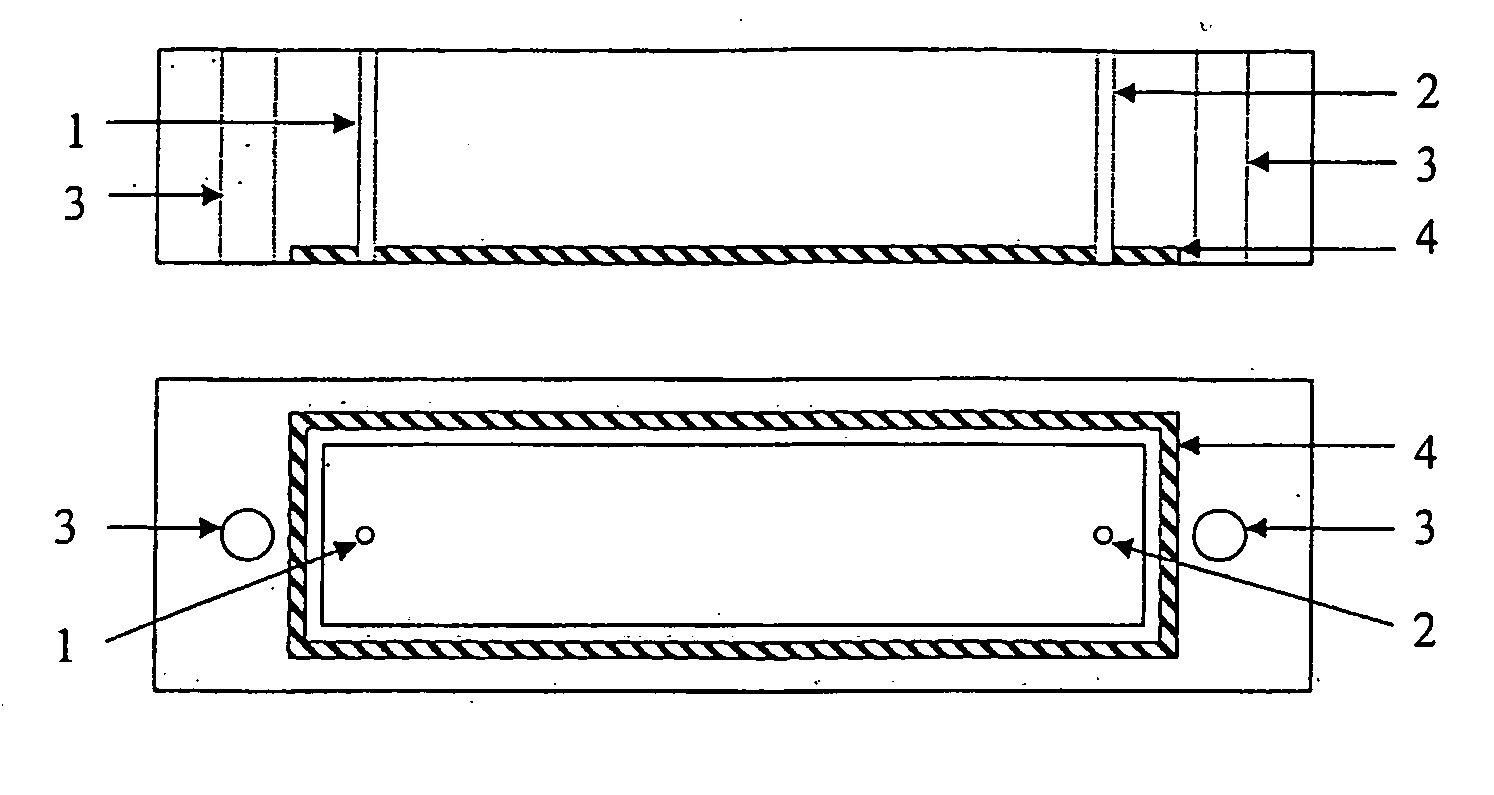Multi-ionophore membrane electerode
- Summary
- Abstract
- Description
- Claims
- Application Information
AI Technical Summary
Benefits of technology
Problems solved by technology
Method used
Image
Examples
example 1
Flow Cell and Electrode Configuration
[0078] The potentiometric flow cell was supplied by Drew Scientific, Cumbria, U.K. FIG. 1 shows a sketch of the flow cell, including the sensors.
[0079] The cell is made from polymethacrylate and consists of an upper part shown from the side (A) and from the bottom (B), and a lower part shown from the top (C) and from the side (D). The upper part (A,B) contains an inlet (1) and an outlet (2) for fluid flow, two holes (3) for bolts and a rubber O-ring seal (4). The lower part (C,D) contains carbon rods (5) of about 1 mm diameter and 2 mm length, inserted so that the top of the carbon rod is level with the bottom of the recesses (6, 7 and 8). The recesses are 2 mm diameter, centred on the centre of the carbon rod and have a depth of 0.1 mm. The recesses are filled with ion-sensing membrane solution (such as those prepared in Example 2 below). Suitably recess (6) contains a potassium sensing membrane, recess (7) contains a mixed ionophore membrane ...
example 2
Preparation of Sensors for Sodium and Potassium Ion Sensing Sodium Ion Sensing Membrane Formulation
[0080] PVC (33%), NPOE (66.25%) and sodium tetrafluorophenylborate (0.15%) were weighed into a glass vial and dissolved in 0.5 mL cyclohexanone by heating at 60° C. for 1 hour. The percentage by weight of each membrane component is expressed in terms of weight per total weight of membrane components. To this mixture was added 0.6% METE (methoxyethyl tetraester calixarene) and the mixture was stirred for a further hour. The total weight of the membrane components was 0.17 g.
Potassium Ion Sensing Membrane Formulation
[0081] PVC (33%), bis(2-ethylhexyl) sebacate (64.5%) and KTCPB (0.5%) were weighed into a glass vial and dissolved in 0.5 mL cyclohexanone by heating at 60° C. for 1 hour. To this mixture was added valinomycin (2.0%) and the mixture was stirred for a further hour. The total weight of the membrane components was 0.17 g.
Mixed Ionophore Membrane Formulation
[0082] PVC (32....
example 3
Pseudo-Reference Electrode for Sodium and Potassium Ion Sensors
[0084] Flow analysis was used to determine the response of the sensors to sodium and potassium ion activity over the ranges found in whole blood. FIG. 3 shows the response of the sensors to injections of sample. The predicted potential shift vs. the actual potential shift is shown in FIG. 4.
[0085] The membranes used in the pseudo reference electrode are prepared as set out in Example 2. The sensors were used in the flow cell of FIG. 1, at a flow rate of 120 uL / min with a sample loop size of 300 uL. The carrier composition was 40 mM bis tris (pH 6.95), 0.8 mM Na2EDTA, 140.4 mM NaCl and 4.2 mM KCl. The calibrants were prepared from a buffer containing 40 mM bis tris (pH 6.95) and 0.8 mM Na2EDTA, and had varying amounts of NaCl and KCl to give the total Na+ and K+ concentrations shown in FIG. 3. The concentrations of sodium and potassium ions were chosen to give all combinations of upper and lower limits of reference and ...
PUM
 Login to View More
Login to View More Abstract
Description
Claims
Application Information
 Login to View More
Login to View More - R&D
- Intellectual Property
- Life Sciences
- Materials
- Tech Scout
- Unparalleled Data Quality
- Higher Quality Content
- 60% Fewer Hallucinations
Browse by: Latest US Patents, China's latest patents, Technical Efficacy Thesaurus, Application Domain, Technology Topic, Popular Technical Reports.
© 2025 PatSnap. All rights reserved.Legal|Privacy policy|Modern Slavery Act Transparency Statement|Sitemap|About US| Contact US: help@patsnap.com



